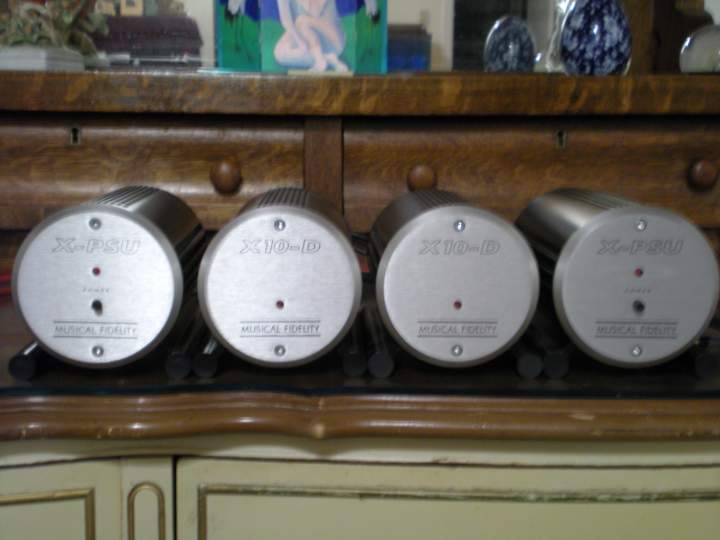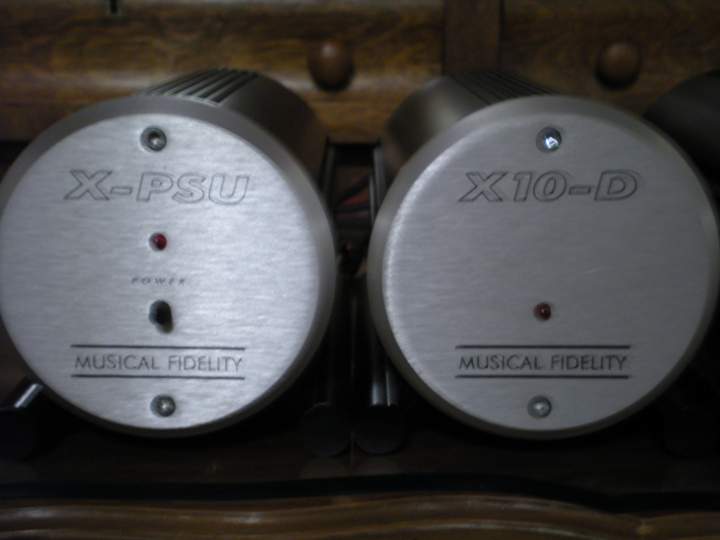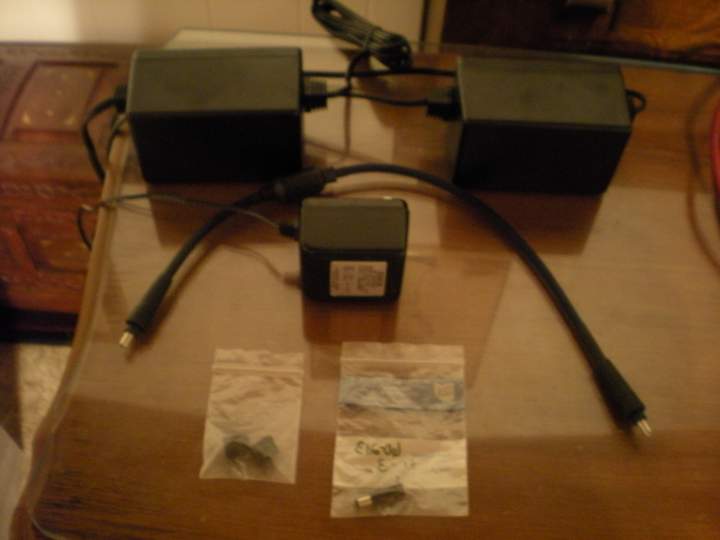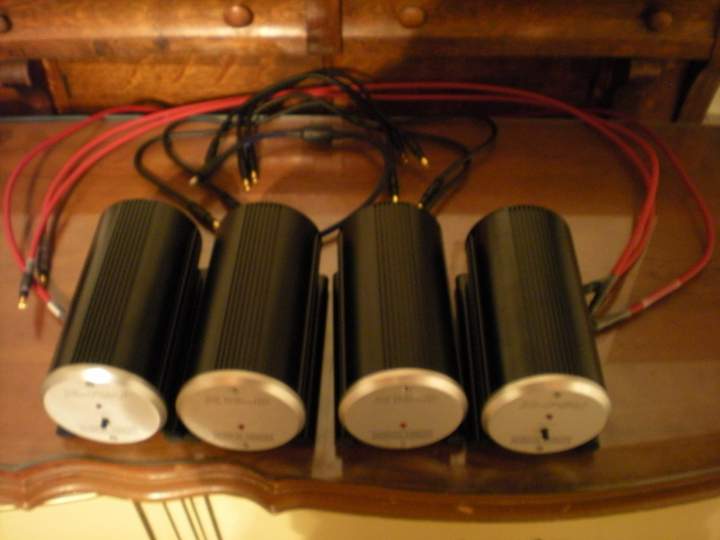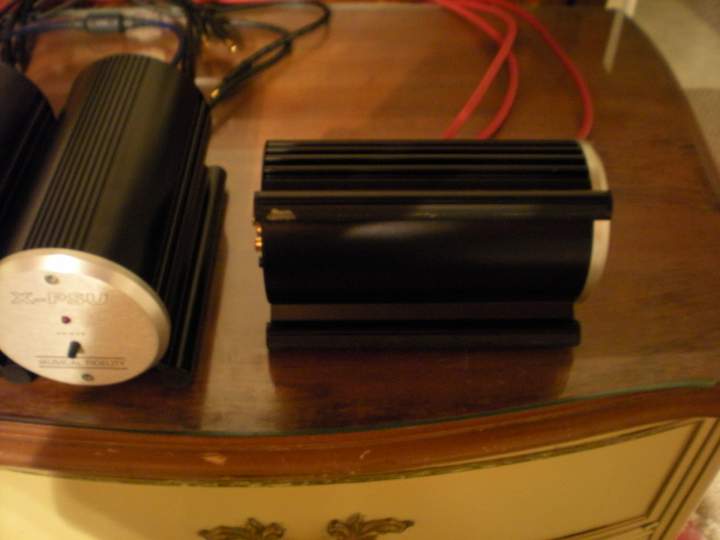ASKING PRICE: $970.
Offered is a set of Musical Fidelity X10-D processors with both their X-PSU (10.5 amp) power supplies. This is the Series I “Missing Link” production. (And for what it’s worth, I think these originals sounded vastly better than the later Series II ones which were square-shaped, and had a supposedly better signal-to-noise ratio.)
Included with this set are:
- 3 18” factory-stock power cords.
- 1 20” aftermarket power cord made with Apature wire and with an AudioQuest RFI blocker put mid-way in the cord. (It is, at best, a miniscule improvement over the factory-stock cords.)
- 2 30” factory-stock power cords.
- 2 four-foot after-market power cords made with AudioQuest “Scarlet Viper” (ICA-I) shielded wire (all-copper center with copper-braided shielding).
- 1 five-foot after-market power cord made with AudioQuest “Scarlet Viper” (ICA-I) shielded wire (all copper center with copper-braided shielding). (These 3 AQ ones were made by the best cable man in the nation, and they do sound better than the factory-stock ones.)
- 2 extra input “pins” for either the X10-D or X-PSU. (I was obviously intending to keep these forever.)
- 1 extra power-cord end.
- 1 set of original factory tubes (which actually sound quite good).
- 1 original factory wall-wart power supply (rated at 850 mA).
- 2 extra Ault brand power supplies (rated at 4.5 amps). (This power supply is the one Sam Tellig reviewed favorably as a cheap alternative to the X-PSU.)
I want to sell all this together because this is how I used it. If, toward the end of this listing it has not sold, then I might consider splitting things up.
The question you’re asking, I’m sure, is why do I have two? Well, believe me, for good reason. My system is all solid-state, and basically, using two X-PSU’s gave it a tube sound. But I bi-amp; one amp for the two satellites (Dunlavy) and one amp for the two subwoofers (Janis). Some people put an X-PSU between their CD player and the pre-amp which works fine. But the X-PSU is a line-level component so you can insert it just about anywhere in your system except between a turntable and the phono pre-amp. So I put one X-PSU between the pre-amp and crossover. This X-PSU has a set of Russian tubes in it. They have a very tight sound—so tight that for the first 200 hours they sounded like transistors. This way I was able to give a slight tube sound to the entire system without muddying the bass. I then put the other X-PSU between the crossover and the amp for the satellites. This X-PSU has Ampex tubes which give a warm bloom to the sound, and thus gave added tube sound to the music without loosening the bass in the subwoofers. The result was that my whole system sounded like a tube system, but without my having had to invest in a lot of tubes for every component. (And I must say that those Musical Fidelity components looked very cool, with the two X-PSU processors on the main rack—one on each side—with the power supplies on two small racks beside the main rack, their power cords going to the processors.)
My system had gorgeous sound set up this way, but woe is me: I just had to spend more money and go for something better all around. So now I am ready to part with this considerable inventory of Musical Fidelity gear.
Note that I am selling all this gear “as is” because none of it has been used in over a year. I suspect everything is fine. The tubes likely will want to spit and grumble for a few hours before they settle down.
Have these been modified? Minimally. You’ve seen these units advertised with the statement made that the LED wire was clipped for better sound. Well, this well-intentioned explanation is rarely the real reason that the LED light got disconnected. The real reason is simple: If you want to change tubes, you have to slide out the circuit board on which they are mounted. (Very easy; I will enclose instructions.) You can slide it out the rear, but this involves removing a fragile screw. So the better way is to slide the circuit board out the front. But the LED wire is too short to allow this. Some people clip it and then re-solder it. Others just leave it unhooked. I, like most people, soldered on a longer piece of wire, which then is tucked under the circuit board when the board is slid back in. I did this to both units, and this is the only modification made—which did not at all affect the sound.
Visual condition is near-mint. I see no marks or blemishes except for one area on the bottom of one X10-D where the rubber on the runner is missing. (Many people have this sort of blemish on the Musical Fidelity units and assume the rubber rubbed off. In all such situations I have seen, they came from the factory this way—the coating method used at the factory apparently not being very effective at times.)
So here is your chance to make your solid-state system sound like a tube system, and also get those extra accessories which have become hard to find.
I do not have the original boxes. I do have one manual for the X10-D processor. I have no manual for the X-PSU, but I don’t recall that it came with one.
I’m going to post all this on Audiogon in a week or two, but thought I would offer it to my nearby audio neighbors first.
Email me, or phone: (314) 966-2167 (afternoons or evenings only).
